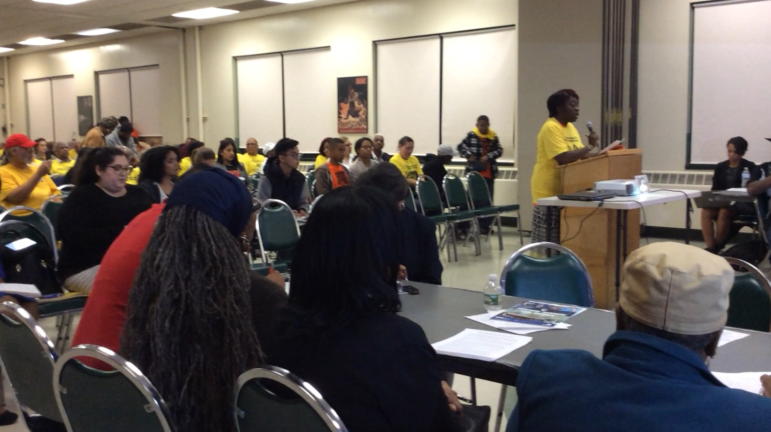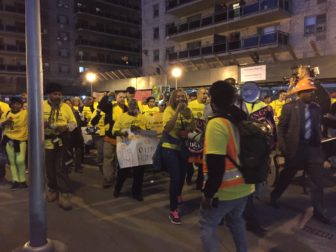
Abigail Savitch-Lew
Chaplain Sandra Mitchell, a member of the Bronx Coalition for a Community Vision, testifies at the Community Board hearing for the Jerome Avenue rezoning ULURP application.
Opponents of the Jerome Avenue rezoning turned out in large numbers for a community board hearing on Wednesday night, hoping to convince board members—some of whom have in the past expressed support for the rezoning—that they really should vote no on the city’s plan.
Yet local councilmember Vanessa Gibson, who will make the ultimate decision on the plan once it reaches City Council, expressed a cautious optimism in conversations with City Limits—a hope that over the next few months she’ll be able to secure stronger commitments to deeply affordable housing and community investments, and ultimately be able to vote yes on a proposal that will benefit, not displace, existing residents.
The rezoning is the fourth of de Blasio’s neighborhood rezoning proposals to move through the seven-month public review process known as the Uniform Land Use Review Procedure (ULURP). It would allow residential buildings on stretches of Jerome Avenue roughly between East 165th Street and East 184th Street and require all developers to set aside a percent of housing as affordable under the city’s mandatory inclusionary housing law. It would also do several other things, like preserve auto and manufacturing zoning in a few areas and establish design requirements in an effort to make new buildings compatible with the elevated 4 train line.
The plan is also part of a larger suite of investments and initiatives: the city has already worked with community groups to conduct a Community District Needs Assessment of the corridor, awarded a nearly $1 million grant for commercial revitalization to the area, begun making streetscaping improvements, and convened a collaborative of groups to create a workforce referral network. Assistance to auto businesses and auto workers, and several strategies to preserve existing affordable housing are also part of the plan, among other initiatives. The city says that given the weak market in the area, much of the construction in the near future would be facilitated by the use of city subsidies and thus require not just a percentage, but 100 percent affordability—though how fast the market will change is difficult to determine.
At the hearing, Gibson testified first, describing the rezoning as a “unique opportunity” to garner investment for the community but emphasizing that she would “not let these investments come at the price of our vibrant neighborhood and its many long-term residents.” She said her vote to approve the zoning depended on the commitment of investments in truly affordable housing, local jobs, education and a variety of other community benefits.
In a private conversation with City Limits, Gibson explained that she did not want to lose the opportunity to bring a huge amount of resources to the area when another future mayor or Council speaker might not offer the same package. She also pointed to the progress made in the city over the past year, from the creation of a universal right to representation in housing court to the passage of the Stand for Tenant Safety Act. And she hopes that economic-development initiatives will ensure her residents do not remain stuck at their current income levels. There are certainly still some things she wants to see, like a certificate of no harassment program, assurances that there will be sufficient housing created for families making the lowest incomes, and passage of her bill to protect auto-businesses.
Others who spoke after her included State Senator Gustavo Rivera and a representative for Assemblymember Latoya Joyner who offered a similar mix of concerns about displacement and optimism for a plan that could work. Rivera stressed the importance of ensuring non-profit developers build 100 percent affordable housing along Jerome Avenue.
Three representatives for property owners in the area each requested that their block or lot be included in the rezoning, thereby allowing them to build affordable housing along with other needed community facilities or retail. (One told City Limits he couldn’t say when the real estate market would be ripe for market-rate housing—though he was “hoping soon.”) A 32BJ rep expressed support for a rezoning and called on the community to secure commitments to good, local jobs with industry-standard wages for building worker employees.
And there were testimonies from advocates—the Women’s Housing and Economic Development Corporation (WHEDco), which had earlier been namechecked by the DCP as a collaborator in the Commercial District Needs Assessment, gave a somewhat scalding critique, saying many of the organization’s comments on the project’s Draft Environmental Impact Statement had not been heeded, and expressed concerns that the rezoning would replace “hundreds of good jobs and their livable salaries” in the auto sector with “lower wage retail jobs.”
It was around 7 o’clock that the audience began to swell with dozens upon dozens of members of the Bronx Coalition for a Community Vision, a robust coalition of unions, clergy organizations and tenant groups that organized in 2014 in response to the initiation of the rezoning study. The group had marched to the venue, where to many members’ irritation they faced a group of NYPD officers who were stationed outside the hearing. The officers, expressing concerns about room capacity, gradually allowed members of the group to enter the hall. “We have a police presence—for senior citizens?” one middle-aged coalition member muttered.

Abigail Savitch-Lew
Members of the Bronx Coalition for a Community Vision arriving in mass to the community board hearing.
One after the other, the Bronx Coalition members urged the board to reject the plan and expressed the same concerns: that the plan would cause displacement, that the affordable housing wouldn’t actually be affordable to low-income residents, that the development would not create good union jobs for locals. Some described living with terrible building conditions; many referenced other areas of the city, from Williamsburg to Harlem, that were rezoned by Bloomberg and then gentrified. One member tried awakening board members’ fears of regret: “How [would] you feel if you were to say yes to this and five years from now, that person who sits next to you in the church pew is no longer here because your vote has ejected them from the community?” he asked.
Beyond raising concerns about how fast the market will change, critics’ main contention is that the city’s best existing subsidy termsheets for affordable housing do not provide sufficient numbers of apartments for the extremely low-income families in the Bronx.
Jerome Avenue is one of the poorest of the neighborhoods currently considering a rezoning: 45 percent of households make less than $20,000, according to statistics provided by the Association for Housing and Neighborhood Development (ANHD) in 2016. The newly revised termsheet for the HPD subsidy program known as ELLA—the Extremely Low Income & Low Income Affordability program—supports mixed-income buildings with 10 percent of apartments for families making less than 30 percent AMI ($25,770 for a family of three) and another 10 percent of apartments for homeless families.

Bronx Coalition for a Community Vision, The Center for Urban Pedagogy, ANHD
A flier given out by the Coalition that explains the difference between the new ELLA program and the income make-up of the local community. ELLA permits some variation in income brackets: check out the actual termsheet here.
As for the labor question, the city already does have HireNYC, which mandates that developers receiving housing subsidies make a good faith effort to work with a Workforce1 center to recruit local applicants for construction jobs. There are no requirements that private developers hire union workers, but the City Council did just pass legislation to require some basic safety training for all workers, union or not. Still, the coalition is demanding more data on HireNYC’s effectiveness as well as calling on HPD to amp up its subsidy requirements “in order to change the status quo of greedy, for-profit affordable housing developers exploiting a vulnerable workforce.”
Following the Community Board ULURP hearing on the Jerome Avenue rezoning proposal, City Limits asked Councilmember Gibson if she shared concerns about the ELLA subsidy program, and if there were greater steps that could be taken to ensure the creation of union jobs.
“I really want to make sure that people get their facts straight because there are a lot of misguided numbers being thrown out here and it’s simply not true. There are measures put in place to provide protections for families that are at $20,000, $25,000 and $30,000 dollars right now and moving forward,” Gibson said, noting the revisions HPD had made to their ELLA termsheet as well as the termsheet for the “Mix and Match” subsidy program. As for the revised version, “I like it but obviously I think we could do a little bit better.”
She also said that it was legally impossible to require developers to hire union workers, but that initiatives like the HireNYC program and the recently passed construction were important measures to ensure good, safe jobs—though more, she acknowledged, still needed to be done.
Listen to her full response yourself:
Following the hearing, Community Boards 4, 5, and 7 will have until October 31 to issue a recommendation on the proposal. In the following months, Bronx Borough President Rubén Díaz Junior, the City Planning Commission, and ultimately the City Council will deliberate the rezoning.
Community Boards 4 and 5 will continue to accept written feedback until Tuesday, October 10 at 5 p.m. Comments can be delivered, mailed, e-mailed or faxed to the addresses below.
Bronx Community Board 4
1650 Selwyn Avenue,
Suite 11A
Bronx, New York 10457
E: bx04@cb.nyc.gov
F: (718) 294-7870
Bronx Community Board 5
Gould Memorial Library (GML) Room 38
Bronx Community College
2155 University Ave, Bronx, NY 10453
E: bx05@cb.nyc.gov
F: (718) 220- 8426









3 thoughts on “Opposition and Cautious Optimism at Jerome Ave Rezoning Board Hearing”
The whole ‘affordable housing’ scheme will end up being payed for by the NYC taxpayer despite what deBlasio says. But the city shouldn’t force this rezoning on the community if they don’t want it. It’s their neighborhood.
As an environmental professional and one who is fighting the same fight on the other side of the Harlem River, the central questions are: Why do these councilmembers not listen to their constituents, and why do they seem to understand Nothing about impacts of development? Clearly we don’t teach students about environmental, infrastructure, societal and service impacts in school. But you can’t just go blindly into these developments, blind to all the horrendous impacts on your neighborhood, just to secure a few affordable units, never mind the gentrification and displacement of your own residents and businesses. Perhaps the media, like this one, can be more helpful in educating our legislators on what happens when you hand the reins over to the real estate industry. And perhaps the media can educate the community more about these issues as well as how much money each legislator is receiving from the real estate industry, well prior to primary elections.
‘Affordability’ has a nice sound to it; but, it doesn’t ‘ring true’ when its real intent is to usher people into the community who make double, triple or more times as much as the average current resident does.
It becomes an Orwellian term.